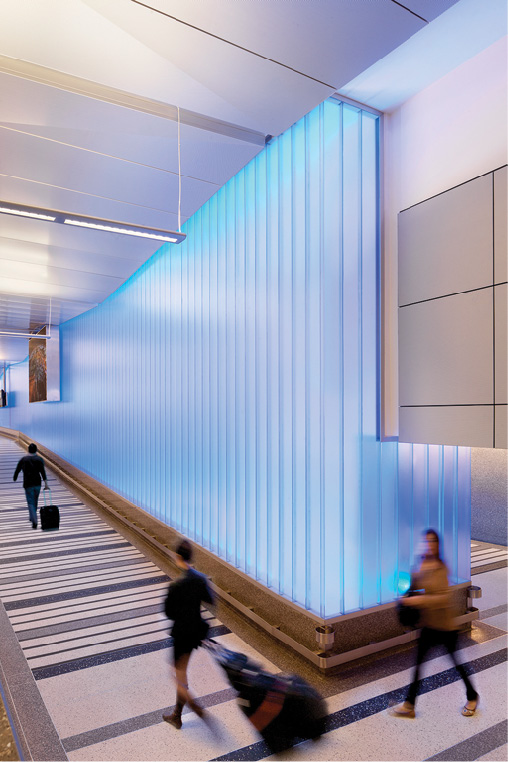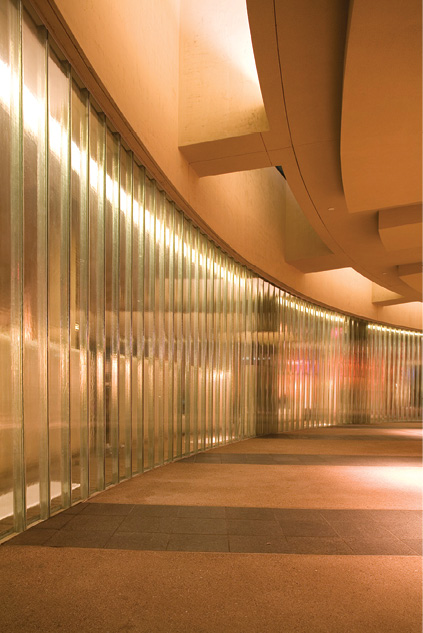Shaping Interiors with Channel Glass
Blending aesthetics and functionality, channel glass is an adaptable and dynamic solution

Outgrowing their purely aesthetic role, decorative glazing assemblies can now blend beauty and functionality in a wide range of designs. Of the many decorative glass options, channel glass has grown in popularity for its ability to create light-filled, sophisticated spaces rooted in elevating occupant experience.
The linear, U-shaped, self-supporting cast glass channels are encased in an extruded metal perimeter frame, enabling single- and dual-glazed designs that cater to crucial aspects like daylighting, energy efficiency and privacy. By using channel glass, building teams can stay abreast of the latest design trends while also successfully balancing style and substance in contemporary interiors and exteriors.
Enhancing comfort
Channel glass diffuses generous amounts of soft, even, natural daylight for an elegant, modern look. Translucent cast glass channels prevent overly direct sunlight, as well as distracting shadows and heat buildup, while also mitigating glare. This, in turn, maximizes natural light while minimizing the need for blinds or windscreens, creating a cleaner aesthetic and enhancing the occupant experience.
Additionally, channel glass with low-emissivity and solar coating supports thermal efficiency. Linear glass segments can be installed to overlap and create an insulating dead-air-filled space between them. This arrangement has a relatively low solar heat gain coefficient, which can further be reduced by filling the air cavity with aerogel insulation. As the insulation is 90% air, the assembly remains translucent and continues to invite a high degree of natural light transfer.
Creating unique spaces

During the evening, channel glass can be backlit with strategically placed LED lights to accentuate a building’s features and provide subtle illumination. The system’s translucency allows for a glowing interior setup, used in well-lit corridors to improve usability and
support wayfinding.
Additionally, unlike opaque materials, channel glass can highlight the silhouette of people walking on both sides. This benefit can be utilized to improve safety in educational settings and offices to create a safer, well-connected and functional building.
Balancing privacy
Just like lighting, balancing privacy and connectivity is crucial for shaping the user experience. With various color and texture options, channel glass facilitates design exploration while addressing privacy.
Channel glass variants offer several levels of translucency, obscuring direct vision while dispersing light. For instance, uncoated double-glazed applications offer a visible light transmittance of 70% to 75%, maximizing both natural light and visibility. In contrast, sandblasting channel glass enhances privacy while maintaining access to daylight, making it an ideal choice for areas such as bathrooms and office lounges. Additionally, channel glass assemblies can provide premium sound insulation with Sound Transmission Class ratings up to 44, contributing to a more comfortable user experience.
Sparking creativity
While supporting occupant experiences, channel glass can push creative boundaries with horizontal, vertical, raked and curved configurations. It can extend vertically up to 13 feet or horizontally up to 23 feet without additional framing members. Channel glass can also be stacked over a floor plate to achieve greater glazing expanses. In addition to linear configurations, glass channels can achieve designs with radii as tight as 6.2 feet, enabling curved and serpentine wall partitions.
Translating design visions
The choice of glass in a building plays a pivotal role in shaping not just the ambiance but also the user experience. Within this realm, channel glass continues to be an adaptable and dynamic solution. It helps champion sophisticated and visually impactful spaces accentuated with diffused natural light, privacy, energy efficiency and acoustic requirements.


